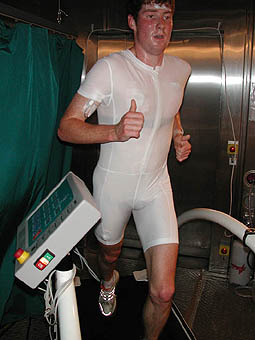Nordische Kombinierer als „Versuchskaninchen“ an der Empa
Schwitzen für die Wissenschaft
Sechs Nordische Kombinierer des Schweizer Nationalkaders schwitzen dieser Tage in der Klimakammer der Empa in St. Gallen als Probanden im Dienste der Wissenschaft. Ihre Anstrengung dient dazu, mehr über die Thermophysiologie zu erfahren. Darauf basierend wollen Empa-Forscher bessere funktionelle Textilien entwickeln, welche Hobby- und Spitzensportler dabei unterstützen, auch „im Schweisse ihres Angesichts“ Top-Leistungen zu erbringen.

|
Legende: Michael Hollenstein auf dem Laufband in der Klimakammer der Empa. Michael Hollenstein joggt seit rund 20 Minuten in einem Tempo,
das ihn an die Grenzen seiner körperlichen Belastbarkeit
bringt. Dann unterbricht der Hochleistungssportler den Lauf kurz.
Der Sportmediziner Dr. Hansueli Backes nimmt ihm am
Ohrläppchen einige Tropfen Blut ab. Und schon gehts weiter, in
gleich bleibendem Trott. Trotz seiner schweisstreibenden
Anstrengung kommt Hollenstein, Mitglied des Schweizer
Nationalkaders der Nordischen Kombinierer, nicht vom Fleck, denn er
joggt auf einem Laufband. Statt in freier Natur läuft der
Sportler in der engen Klimakammer der Empa in St. Gallen, unter
streng kontrollierten Bedingungen bei 28 Grad Lufttemperatur
und Schwitzen und sich dabei wohl fühlen Wer an heissen Tagen körperlich aktiv ist, dem rinnt der Schweiss förmlich «aus allen Poren». Dies verhindert, dass der Körper überhitzt. Trotzdem: Die Feuchtigkeit wird als unangenehm empfunden, besonders wenn sie in den Kleidern „haften“ bleibt. Hier hilft „funktionelle“ Bekleidung, welche die Verdunstungskühlung des Körpers unterstützt. Bei Sportlern ist funktionelle Bekleidung daher besonders gefragt, bei den Profis ebenso wie im Breitensport. Die Empa untersucht im Projekt „Sweat Management“ den Einfluss der Kleidung auf die Wärme- oder Thermoregulation des menschlichen Körpers. „Jede Art von Bekleidung stellt eine Isolation für den Körper dar und beeinflusst die menschliche Thermoregulation“, sagt Projektleiter Andreas Jack von der Empa-Abteilung Schutz und Physiologie. „Wir untersuchen, wie dieser Isolationseffekt auch mit Textilien möglichst gering gehalten werden kann.“ Die Empa beschäftigt sich mit dem Thema schon seit langer Zeit. Um das menschliche Schwitzen simulieren zu können, entwickelte sie sogar eigens einen schwitzenden Roboter namens SAM (für Sweating Agile Manikin), eine bewegliche Gliederpuppe, die aus -zig Düsen wie ein Mensch schwitzt. SAM ersetzt allerdings nicht die Probandenversuche, bei denen sich Freiwillige im Dienst der Wissenschaft sportlich belasten. Nötig sind diese, um die individuellen Unterschiede in der Thermoregulation zu analysieren, und um subjektive Aussagen der einzelnen Probanden zu erhalten.
|
||||
|
Nordische Kombinierer auf der Tretmühle |
|||
|
Durch dieses so genannte „Body Mapping“ wollen Andreas Jack und seine Kollegen die Thermoregulation des menschlichen Körpers optimal unterstützen, letztlich also durch eine entsprechende Materialkombination eine Art „zweite Haut“ schaffen. Die verschiedensten medizinischen Parameter werden während des Laufs regelmässig von Sportmediziner Backes kontrolliert, denn die Anstrengung bringt die Sportler an ihre Leistungsgrenze, ihre Körpertemperatur steigt auf Fieberniveau. Der vergossene Schweiss wird gesammelt und später im Labor untersucht. Nach dem Lauf werden die Sportler nach ihrem subjektiven Eindruck befragt, also: „Wie fühlten sie sich, welchen Anzug haben sie als angenehmer empfunden und warum?“ Danach werden diese Aussagen mit den gemessenen Daten wie Hauttemperatur, Kerntemperatur, Herzfrequenz, Laktat- und Somatropinwerte usw. verglichen, um so den Anzug weiter zu optimieren. Wieso aber nehmen Sportler überhaupt solche Mühen auf sich? „Für uns ist das durchaus eine Win-Win-Situation“, sagt dazu Hippolyt Kempf, der 1988 in der Nordischen Kombination Olympiasieger geworden war und derzeit im nationalen Skiverband Swiss-Ski als Chef der nordischen Sportarten amtiert. Neben dem finanziellen „Zustupf“ erhalten Kempf und seine Sportler medizinisch belegte Aussagen über ihren Trainingszustand und dessen Veränderung als Reaktion auf die wiederholte Belastung. Die Empa und ihre Partner ihrerseits – das Beschaffungszentrum der Schweizer Armee „armaswiss“ und der Schweizer Textilhersteller Christian Eschler AG – kommen zu Daten von Spitzensportlern und können diese mit jenen von Breitensportlern vergleichen, die sich der Empa ebenfalls als Probanden zur Verfügung gestellt haben. Bessere Sportbekleidung soll ja nicht nur den Profis zugute kommen, sondern auch den vielen HobbysportlerInnen. Autor: Rémy Nideröst Fachliche Auskunft Hippolyt Kempf, Bundesamt für Sport (BASPO), Tel. 032 327 65 38, |
||||

